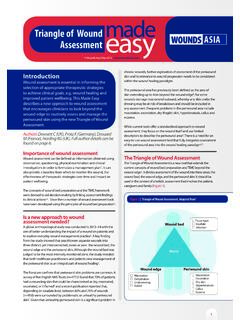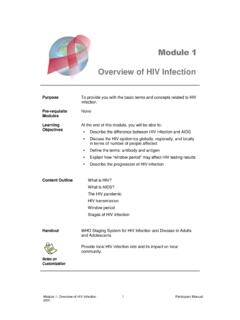Transcription of Wound Assessment form - Coloplast
1 Wound Assessment form Date: Patient Name: Patient ID: Assessor Name: Patient Age: years Weight: kgs Gender: Male Female Nutrition status: Well nourished Malnourished Mobility status: Good Mobility Bad Mobility Smoking: Yes No If yes, how many/day: Alcohol: Yes No If yes, units/week: Co-morbidities: Venous disease Arterial disease Diabetes Anaemia Other: Medications: Allergies: ABPI (done): Yes No If yes,measurement: Date: Wound description Wound type(s): Duration of Wound (s): Previous treatment(s): Size: length mm width mm depth mm Wound location(s): Information about location(s): Pain level: 0 1 2 3 4 5 6 7 8 9 10. No pain Moderate pain Worst pain If any pain, is it: Constant At dressing changes Wound bed Assessment Wound bed Assessment Tissue type Exudate Infection Necrotic % G. Sloughy % Ep Wound bed Level Dry Low Wound . Type Thin/watery Purulent Wound edge Assessment Periwound skin Assessment Wound edge Periwound skin Local Increased pain Erythema Oedema Local warmth Increased exudate Delayed healing Necrotic % Granulating %.
2 Friable granulation tissue Malodour Wound bed Assessment Pocketing Sloughy Tissue type % Epithelialising %. Necrotic % Granulating %. Nectotic % Granulating %. Sloughy % Epithelialising %. Sloughy % Epithelialising %. Exudate Level Dry Low Medium High Level Type Level Thin/watery Dry Thick Low Dry Low Cloudy Medium Medium High High Purulent Clear Pink/red Type Thin/watery Cloudy Thick Purulent Local Type Clear Pink/red Thin/watery Spreading/systemic Cloudy Thick Increased pain Increased erythema Infection Erythema Pyrexia Local Oedema Purulent Abscess/pus Spreading/systemic Clear Pink/red Increased Local warmth pain Wound breakdown Increased erythema Increased exudate Cellulitis Erythema Delayed healing General malaise Pyrexia Oedema Friable granulation tissue Raised WBC count Abscess/pus Malodour Lymphangitis Local Local warmth Pocketing Wound breakdownSpreading/systemic Increased exudate Cellulitis Increased Delayed healing pain General malaise Increased erythema Erythema Friable granulation tissue Raised WBC count Pyrexia Malodour
3 Lymphangitis Pocketing Oedema Abscess/pus Swab taken: LocalYeswarmth No Wound breakdown If yes, result: Date: Increased exudate Cellulitis Delayed healing General malaise Friable granulation tissue Raised WBC count Wound edge Wou Wound edge Assessment Wound bed Assessment Maceration Dehydration Wound bed Undermining Wound edgeWOUND. Wound Assessment Rolled edges Wound edge Assessment Wound Assessment Periwound skin Assessment d Assessment Maceration Wound edge Maceration Periwound skin Dehydration Undermining Thickened/rolled edges Dehydration Wound edge Assessment Wound edge Wound Assessment Maceration Maceration Undermining Undermining Mark position of undermining Dehydration Rolled edges Extent: ____ cm Dehydration Rolled edges ssment skin Assessment Undermining Periwound skin Assessment Periwound skin Wou Rolled edges WoundAssessment Wound bed Assessment Maceration Excoriation Wound bed Dry skin Wound edge Assessment Wound .
4 Periwound skin Assessment Maceration Hyperkeratosis Excoriation Wound edge Periwound skin Dry skin Hyperkeratosis Callus Callus Eczema Eczerma Periwound skin Assessment Periwound skin Wound Assessment Maceration Maceration cm CM Hyperkeratosis cm Excoriation cm Callus cm ExcoriationDry skin cm CM Eczema cm Dry skin CM. Status Is the Wound : N/A- First visit Deteriorating Static Improving Hyperkeratosis CM. Callus CM. Eczerma CM. Management goals Tick all appropriate Wound bed Assessment management goals Management goals Remove non-viable tissue Manage exudate Manage bacterial burden Rehydrate Wound bed Wound bed Protect granulation/epithelial tissue Wound . Wound edge Assessment Periwound skin Assessment Wound edge Periwound skin Management goals Management goals Manage exudate Manage exudate Rehydrate Wound edge Protect skin Remove non-viable tissue Rehydrate skin Protect granulation/epithelial tissue Remove non-viable tissue Wound Management Goals Type all management goals: Treatment choice Treatment: Dressing type/name: Reason for choosing dressing: Follow up plan Date of next visit: Main objective at next visit: Date of reassessment: Refferal needed: Yes No If yes, to who: Date: Coloplast A/S, Holtedam 1, 3050 Humlebaek, Denmark The Coloplast logo, Triangle of Wound Assessment , and the related graphic are registered trademarks of Coloplast A/S.
5 2017-06. All rights reserved Coloplast A/S.






